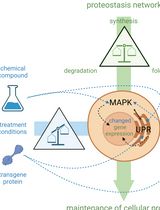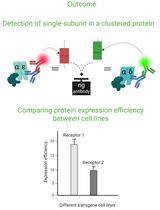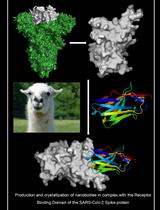- EN - English
- CN - 中文
Transient yet Robust Expression of Proteins in the Mouse Liver via Intravenous Injection of Lipid Nanoparticle-encapsulated Nucleoside-modified mRNA
通过静脉注射脂质纳米颗粒包裹的核苷修饰的 mRNA 蛋白质在小鼠肝脏中瞬时而稳定地表达
(*contributed equally to this work) 发布: 2021年10月05日第11卷第19期 DOI: 10.21769/BioProtoc.4184 浏览次数: 6134
评审: Zinan ZhouJake J. WenRAMESH KUDIRA

相关实验方案

Cell-Sonar:通过特定蛋白标志物表达变化追踪目标蛋白的简便低成本方法
Sabrina Brockmöller [...] Simone Rothmiller
2025年02月05日 1605 阅读

Cluster FLISA——用于比较不同细胞系蛋白表达效率及蛋白亚基聚集状态的方法
Sabrina Brockmöller and Lara Maria Molitor
2025年11月05日 1122 阅读
Abstract
With the recent availability of the SARS-CoV-2 mRNA-based vaccines, public attention has been drawn to this new technology and how it may be applied to other indications. Temporal activation of key hepatic regenerative pathways can induce liver regeneration, overcoming the lack of donor organs for liver transplantation and ineffectiveness of alternative treatments. Recombinant protein therapies and genetic therapies that target these pathways require frequent and repeated injections or, when integrated into the genome, may lead to deleterious effects. In contrast, nucleoside-modified mRNA encapsulated in lipid nanoparticles (mRNA-LNP) are non-integrative and induce transient yet robust expression of proteins that could serve as an ideal therapeutic tool to treat specific liver diseases. For instance, our recent publication in Nature Communications used mRNA-LNP to express hepatic mitogens, hepatocyte growth factor, and epidermal growth factor to induce liver regeneration following both acute and chronic liver injuries. Initial testing with firefly luciferase mRNA-LNP transfection and in vivo imaging confirmed specific hepatotropic delivery. In this protocol, we describe in detail the necessary steps to deliver mRNA-LNP to the murine liver and, following intravenous injection of eGFP mRNA-LNP, verify transfection efficiency using flow cytometry and liver cell specificity using immunofluorescence analyses. This procedure presents an unprecedented tool that can be customized with mRNA-LNP encoding any protein of interest to be expressed by virtually all hepatocytes, ~70% endothelial cells, and ~40% Kupffer cells for promoting liver function and/or regeneration.
Graphic abstract:

Experimental Design of mRNA-LNP IV Injection and Analysis of Liver Cell Specificity and Efficiency of Transfection (Created with BioRender.com)
Background
Recently, interest has been garnered for the use of nucleoside-modified mRNA-LNP (mRNA-LNP) due to their safe, non-integrative nature, as well as for their fame in the new publicly available SARS-CoV-2 vaccines produced by Pfizer-BioNTech and Moderna. Unlike viral gene delivery systems that come with a risk of mutagenesis and systemic adverse effects, intravenously administered mRNA-LNP are directed to the liver, with robust yet transient protein expression induced for only about 5 days (Rizvi et al., 2021). mRNA-LNPs also provide an advantage over recombinant protein replacement therapy, which has limitations due to short protein half-life, requiring repetitive dosing to achieve benefit (Chan et al., 1991; Appasamy et al., 1993; Ido et al., 2004; Hardwicke et al., 2008). Other methods for delivering protein expression to the liver, such as ASGPR-mediated hepatocyte targeting, also come with limitations such as off-target effects and reduced effectiveness in diseased conditions (D’Souza and Devarajan, 2015).
Previous studies have shown that mRNA-LNPs are effective in treating several hepatic diseases that have a single gene mutation, such as alpha-1 antitrypsin deficiency and Crigler-Najjar syndrome type 1. In these cases, mRNA-LNP treatment is more potent than traditional protein replacement therapy, as it can be delivered in smaller volumes and allows the native cell machinery to translate the proteins and apply the appropriate post-translational modifications, and mRNA-LNPs are easier and cheaper to produce than recombinant proteins (Trepotec et al., 2018). mRNA-LNP-encoded Cas9 can also be used as a tool for in vivo gene editing to correct these single-gene mutations (Yin et al., 2016). Clinical trials are currently underway testing the therapeutic benefit of mRNA-LNP for applications such as vaccines, cancer immunotherapy, cancer treatment, and as an alternative to the many diseases currently being treated with protein replacement therapy (Sahin et al., 2014; Pardi et al., 2018; Magadum et al., 2019).
In this application, our LNP formulation targets the liver, as shown with the restricted presence of luciferase activity in the liver after luciferase mRNA-LNP injection (Rizvi et al., 2021), by binding circulating apolipoprotein E (ApoE) that in turn targets ApoE receptors on the surface of hepatocytes (Akinc et al., 2010). Using injection of eGFP mRNA-LNP, we specifically demonstrated that only parenchymal cells of the liver were transfected among other organs tested. We also detected expression of eGFP in endothelial cells of the liver, spleen, and intestine, and in CD45+ blood cells, most likely monocytes/macrophages, in the liver, spleen, intestine, and lungs following eGFP mRNA-LNP injection. Nevertheless, liver tropism can be altered by modifying the LNP formulation, route of administration, or by conjugating with specific antibodies for other cell types to redirect the mRNA-LNP away from the liver (Parhiz et al., 2018). This protocol provides a step-by-step description for the utilization of mRNA-LNP to induce rapid, robust, and transient expression of any genes directly and specifically to the liver. As a proof-of-principle, we demonstrated that mRNA-derived protein expression is stable for 3-4 days after administration of luciferase mRNA-LNP as luciferase activity was the highest in the liver 5 hours after injection and lasted 3-4 days (Rizvi et al., 2021). We have validated the efficiency and clinical benefit of this protocol to deliver hepatic mitogens to accelerate the regeneration of the liver from acetaminophen-induced acute liver injury and CDE diet-induced NAFLD-like chronic liver injury (Rizvi et al., 2021). This protocol can be tailored to express any protein of interest in virtually all hepatocytes, most endothelial cells, and a subpopulation of Kupffer cells of the liver. Overall, this protocol provides a fully validated protein expression strategy to the liver that can be broadly utilized for therapeutic intervention of liver disorders via transient, robust, and cell-specific expression via nucleoside-modified mRNA-LNP.
Materials and Reagents
mRNA-LNP production:
T7 RNA polymerase (Megascript, Ambion, catalog number: AMB13345)
One-methylpseudouridine (m1Ψ)-5’-triphosphate (TriLink, catalog number: N-1081)
m7G capping kit with 2’-O-methyltransferase (ScriptCap, CellScript, catalog number: C-MSC11610)
Fast Protein Liquid Chromatography (FPLC) (Akta Purifier, GE Healthcare)
Agarose (Denville Scientific, catalog number: CA3510-8)
TAE buffer (Promega, catalog number: V4271)
mRNA-LNP to be stored at -80°C
Note: All nucleoside-modified mRNAs are available from the company RNAx created by Dr. Drew Weissman.
eGFP DNA sequence used for mRNA synthesis:
ATGGTGAGCAAGGGCGAGGAGCTGTTCACCGGGGTGGTGCCCATCCTGGTCGAGCTGGACGGCGACGTAAACGGCCACAAGTTCAGCGTGTCCGGCGAGGGCGAGGGCGATGCCACCTACGGCAAGCTGACCCTGAAGTTCATCTGCACCACCGGCAAGCTGCCCGTGCCCTGGCCCACCCTCGTGACCACCCTGACCTACGGCGTGCAGTGCTTCAGCCGCTACCCCGACCACATGAAGCAGCACGACTTCTTCAAGTCCGCCATGCCCGAAGGCTACGTCCAGGAGCGCACCATCTTCTTCAAGGACGACGGCAACTACAAGACCCGCGCCGAGGTGAAGTTCGAGGGCGACACCCTGGTGAACCGCATCGAGCTGAAGGGCATCGACTTCAAGGAGGACGGCAACATCCTGGGGCACAAGCTGGAGTACAACTACAACAGCCACAACGTCTATATCATGGCCGACAAGCAGAAGAACGGCATCAAGGTGAACTTCAAGATCCGCCACAACATCGAGGACGGCAGCGTGCAGCTCGCCGACCACTACCAGCAGAACACCCCCATCGGCGACGGCCCCGTGCTGCTGCCCGACAACCACTACCTGAGCACCCAGTCCGCCCTGAGCAAAGACCCCAACGAGAAGCGCGATCACATGGTCCTGCTGGAGTTCGTGACCGCCGCCGGGATCACTCTCGGCATGGACG AGCTGTACAAG
In vivo administration of mRNA-LNP:
Dulbecco’s Phosphate Buffered Saline (DPBS 1×), Sterile, (-) Calcium Chloride, (-) Magnesium Chloride (Gibco, catalog number: 14190-144)
Isothesia Isoflurane, USP (Henry Schein Animal Health, catalog number: 029405)
1/2cc Lo-Dose Insulin Syringe, 0.5 ml, 29 G, sterile (Exel International, catalog number: 26028)
Tissue fixation, cryopreservation, sectioning, and immunofluorescence on sections:
FluorSave reagent (EMD Millipore Corp, MilliporeSigmaTM, catalog number: 345789-20ML)
Triton-X 100 (Sigma Life Science, catalog number: T9284-100ML)
16% Paraformaldehyde Aqueous Solution, EM Grade (Electron Microscopy Sciences, catalog number: 15710)
Tissue Plus 4585 O.C.T. Compound, Clear (Fisher Healthcare, catalog number: 23-730-571)
Sucrose (MP Biomedicals, LLC, catalog number: 0219401891)
Normal Donkey Serum (Jackson ImmunoResearch Laboratories, Inc., catalog number: 017-000-121)
Note: Storage of freeze-dried powder at 2-8°C. After rehydration, aliquot undiluted serum, and store at -20°C or below.
DAPI, 4',6-Diamidino-2-Phenylindole, Dilactate (Invitrogen, Molecular Probes, catalog number: D3571)
Note: Storage of powder at room temperature. After rehydration, aliquot undiluted solution, and store at -20°C or below.
Liver perfusion and flow cytometry:
Intravenous (I.V.) administration set (Med Vet International, IV10, Fisher Scientific, catalog number: NC0196893)
Catheter, IV, 24 G × 3/4", Sterile, SURFLO®, (TerumoTM, catalog number: SROX2419CA)
Pump Tubings, 3P Set of 12 PVC Flow Tubes of 1.52 mm (Gilson Inc, catalog number: 3P F117942)
40 µm Sterile Cell Strainer (Fisher Scientific, Fisherbrand, catalog number: 22-363-547)
100 µm Sterile Cell Strainer (Fisher Scientific, Corning, catalog number: 07-201-432)
60 mm Petri Dish (Fisher Scientific, Fisherbrand, catalog number: FB0875713)
1cc Insulin Syringe, 1.0 ml, 28 G, sterile (Exel International, catalog number: 26027)
Round-Bottom Polystyrene Test Tubes with Cell Strainer Snap Cap (Falcon, catalog number: 352235)
Liver Perfusion Medium 1×, called “Solution 1” in procedure, ~30 ml per mouse (ThermoFisher Scientific, Gibco, catalog number: 17701038)
Note: Store at 2-8°C protected from light.
Earl’s Balanced Salt Solution (EBSS), Ca2+, Mg2+, phenol red, pH 7.4, called “Solution 2” in procedure, ~20 ml per mouse (ThermoFisher Scientific, Gibco, catalog number: 24010043)
Note: Store at 2-8°C.
Liver Digest Medium, called “Solution 3” in procedure, ~50 ml per mouse (ThermoFisher Scientific, Gibco, catalog number: 17703034)
Note: Store from -20°C to -5°C, protected from light.
Hepatocyte Wash Medium (ThermoFisher Scientific, Gibco, catalog number: 17704024)
Note: Store at 2-8°C protected from light.
Collagenase Type IV (Worthington Biochemical Corporation, catalog number: LS004188)
Note: Store at 2-8°C.
DNase I, Deoxyribonuclease I, from bovine pancreas (Sigma-Aldrich, catalog number: DN25) Note: Store at -20°C.
Trypsin-EDTA (1×), 0.05%, phenol red (ThermoFisher Scientific, Gibco, catalog number: 25300-054)
Note: Store at -5°C to -20°C.
Phosphate Buffered Saline (PBS), 10× solution (Fisher Scientific, Fisher BioReagents, catalog number: BP39920)
Note: Dilute to 1× working solution prior to use for most applications.
Small Cotton-Tipped Applicators, 3 inches, Wooden Shaft, Sterilized (Fisher Scientific, Fisherbrand, catalog number: 23-400-118)
Note: Autoclave to sterilize.
Ketamine Hydrochloride (Covetrus, catalog number: 056344)
Note: Controlled substance.
Xylazine Hydrochloride (MP Biomedicals, catalog number: 0215830701)
Dulbecco’s Phosphate Buffered Saline (DPBS 1×), Sterile, (-) Calcium Chloride, (-) Magnesium Chloride (Gibco, catalog number: 14190-144)
Fc Block, CD16/CD32 Purified Rat anti-Mouse (BD Biosciences, BD Pharmingen, catalog number: 553141)
Note: Store undiluted at 4°C.
Ethylenediaminetetraacetic acid (EDTA), 0.5M, UltraPureTM, pH 8.0 (Life Technologies, Invitrogen, catalog number: 15575-038)
Fetal Bovine Serum (FBS) Characterized (GE Life Sciences, HyCLone, catalog number: SH30071.03)
Note: Store at -10°C or below.
Zombie NIR Fixable Viability Dye (Biolegend, catalog number: 423105)
Note: Store at -20°C in a dry place protected from light.
Red Blood Cell Lysing Buffer Hybri-Max (Millipore Sigma, Sigma Aldrich, catalog number: R7757-100ML)
Antibodies (Table 1)
Table 1. List of antibodies used for immunofluorescence on frozen fixed tissues (IF-Fr) and flow cytometry (FC)
Antibody Cat. No Species Application Dilution GFP A10262 (Invitrogen) Chicken IF-Fr 1:300 HNF4α sc-6556 (Santa Cruz) Goat IF-Fr 1:50 CK19 602-670 (Abbomax) Rabbit IF-Fr 1:100 CD31 557355 (BD Pharmingen) Rat IF-Fr 1:100 CD45 NB100-77417 (Novus) Rat IF-Fr 1:100 α-SMA 19245S (Cell Signaling) Rabbit IF-Fr 1:300 F4/80 sc25830 (Santa Cruz) Rabbit IF-Fr 1:100 CD31-PE/Dazzle 594 102429 (BioLegend) Rat FC 1:40 CD11b-PE efluor 610 61-0112-80 (Invitrogen) Rat FC 1:80 CD45-PE efluor 610 61-0451-80 (Invitrogen) Rat FC 1:40 DNase I stock solution (10 mg/ml) (see Recipes)
NPC Digest Solution (see Recipes)
Wash Medium (see Recipes)
Ketamine/Xylazine Anesthetic Solution (see Recipes)
FACs Buffer (see Recipes)
4% Paraformaldehyde (see Recipes)
3% Normal Donkey Serum (see Recipes)
DAPI stock solution (see Recipes)
Equipment
Magnetic Stirring Bars (Fisherbrand, catalog number: 14512132)
HotHands Hand Warmers, used as heating pads for anesthetized mice (Kobayashi Consumer Products, LLC, hothands.com)
Flow cytometer (Stratedigm, S1000 Exi 3 laser, 10 detector)
Peristaltic perfusion pump (Gilson, model: Minipuls 3, catalog number: F155005)
High-speed refrigerated centrifuge (Eppendorf, model: 5804R, catalog number: 022623508)
Fluorescence microscope (Nikon, model: Eclipse Ni-E)
Cryostat (Leica, catalog number: CM1950)
Magnetic stirrer (Research Productions Inc., Biomega)
Zetasizer Nano ZS dynamic light scattering instrument (Malvern Instruments Ltd, Malvern, UK)
Electrophoresis machine (Bio-Rad)
Software
FlowJoTM Software for Mac, Version 10.7.1. (Becton, Dickinson and Company, Ashland, OR. 2019. https://www.flowjo.com/)
Fiji – ImageJ image processing software (Schindelin et al., 2012)
Procedure
文章信息
版权信息
© 2021 The Authors; exclusive licensee Bio-protocol LLC.
如何引用
Everton, E., Rizvi, F., Smith, A. R., Beattie, M., Tam, Y., Pardi, N., Weissman, D. and Gouon-Evans, V. (2021). Transient yet Robust Expression of Proteins in the Mouse Liver via Intravenous Injection of Lipid Nanoparticle-encapsulated Nucleoside-modified mRNA. Bio-protocol 11(19): e4184. DOI: 10.21769/BioProtoc.4184.
分类
生物化学 > 蛋白质 > 表达
生物工程 > 生物医学工程
您对这篇实验方法有问题吗?
在此处发布您的问题,我们将邀请本文作者来回答。同时,我们会将您的问题发布到Bio-protocol Exchange,以便寻求社区成员的帮助。
Share
Bluesky
X
Copy link










